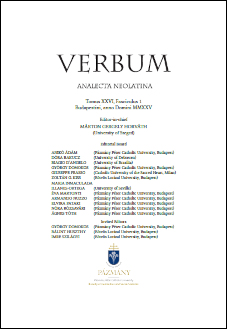Megjelent 2025-07-10
Kulcsszavak
- comunicazione diplomatica,
- crittazione,
- segmentazione testuale,
- punteggiatura,
- caratteristiche strutturali,
- interpretazione
Hogyan kell idézni
Copyright (c) 2025 Judit W. Somogyi

This work is licensed under a Creative Commons Attribution 4.0 International License.
Absztrakt
In Italia nell’ambito delle relazioni politiche e diplomatiche dei secoli XV–XVI una quantità notevole di messaggi fu inviata ai destinatari in forma cifrata. Divenne parte della procedura del crittosistema monoalfabetico usato ampiamente durante il periodo in questione che nel corso della codifica e/o decodifica, oltre alla sostituzione dei grafemi, di frequente si modificarono caratteristiche di scrittura del testo. Alcune delle modifiche hanno interessato le marcature riferite alla struttura logica e morfosintattica del testo, ad esempio la versione codificata è stata scritta per lo più omettendo spazi e segni di interpunzione. Nel processo di decodifica del testo così ridotto è stato necessario inserire di nuovo le segnalazioni riferite alla struttura, poiché la loro mancanza avrebbe ostacolato notevolmente l’interpretazione del testo secondo le intenzioni del mittente. Lo studio prende in analisi versioni cifrate di manoscritti in volgare con lo scopo di individuare in esse tracce d’intenzione volta a rappresentare le proprietà strutturali del testo.
Hivatkozások
- Alberti, L. B. (1568): De Cifris. In: Bartoli, C. (ed.) Opuscoli morali di Leon Battista Alberti. Venezia: Francesco Franceschi Sanese. 200–224. https://archive.org/details/bub_gb_Xju09GVJL6YC/page/n203/mode/1up?view=theater [ultima consultazione: 10 giugno 2024]
- Berardi, L. & A. Beutelspacher (2001): Crittologia. Come proteggere le informazioni riservate. Milano: Franco Angeli.
- Cevolini, A. (2009): Punteggiare la comunicazione e comunicare la punteggiatura. La Bibliofilía CXI 3: 301–307.
- Coluccia, R. (2008): Teorie e pratiche interpuntive nei volgari d’Italia dalle origini alla metà del Quattrocento. In: Mortara Garavelli, B. (ed.) Storia della punteggiatura in Europa. Bari: Editori Laterza. 65–98.
- Ferrari, A. (2021): La punteggiatura italiana oggi. Virgola e connettivi pragmatici. In: E. Banfi, P. Diadori & A. Ferrari (eds.) Didattica della punteggiatura italiana a apprendenti giapponesi, coreani, vietnamiti, cinesi e arabi. Siena: Edizioni Università per Stranieri di Siena. 3-17.
- Geymonat, M. (2008): Antichità greca e latina, cultura bizantina e latinità medievale. In: B. Mortara Garavelli (ed.) Storia della punteggiatura in Europa. Bari: Editori Laterza. 27–63.
- Kahn, D. (1996): The Codebreakers – The Story of Secret Writing (Revised edition). London: Weidenfeld and Nicholson.
- Maraschio, N. (2008): Il secondo Cinquecento. In: B. Mortara Garavelli (ed.) Storia della punteggiatura in Europa. Bari: Editori Laterza. 122–137.
- Palma, D., G. Palma & M. V. Palma (2013): La lettera svelata di Lucrezia Borgia: analisi del sistema criptografico nel documento conservato in ASMo. Quaderni Estensi 5: 510–524. http://www.quaderniestensi.beniculturali.it/QE5/QE5_notizie_palma.pdf
- Parkes, M. B. (1992): Pause and Effect. An Introduction to the History of Punctuation in the West. Berkeley/Los Angeles: Scolar Press.
- Richardson, B. (2008): Dalla metà del Quattrocento alla metà del Cinquecento. In: B. Mortara Garavelli (ed.) Storia della punteggiatura in Europa. Bari: Editori Laterza. 99–121.
- Senatore, F. (2003): “Uno mundo de carta”. Forme e strutture della diplomazia sforzesca. Napoli: Liguori.
- W. Somogyi, J. (2020a): Sifrírozási szabályok késő-középkori rejtjelkulcsok tükrében. In: I. Boros (ed.) Fideliter servanda. II. Scriptorium konferencia, Pannonhalma, 2018. május 7–8. Budapest: Szent István Társulat. 317–328.
- W. Somogyi J. (2020b): Kapcsolódások és összefüggések késő-középkori rejtjelezési dokumentumok között. In: Gy. Domokos, J. W. Somogyi & M. Szovák (eds.) Italianista tanulmányok a magyar humanizmus és a tizenöt éves háború idejéről. Vestigia 3. Budapest: Balassi. 216–232.
- W. Somogyi, J. (2023): Kéziratos szöveg(re)produkció Itáliában a kora újkor kezdetén In: I. Boros & L. Takács (eds.) Aut lego vel scribo. Budapest: Szent István Társulat, Bölcsészettudományi Kutatóközpont, Moravcsik Gyula Intézet. 233–242.

